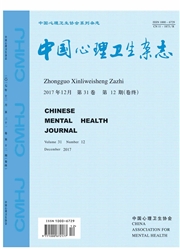

 中文摘要:
中文摘要:
目的:探讨脑特异性血管发生抑制剂1相关蛋白2(鲋M尸2)基因多态与儿童注意缺陷多动障碍(ADHD)共患学习困难(LD)的关联。方法:选取符合美国精神障碍诊断与统计手册第4版(DSM—IV)诊断标准731例共患LD的ADHD儿童和957例健康对照,采用高通量实时荧光定量PCR方法检测基因型,探讨BAIAP2基因的9个单核苷酸多态性(SNPs)位点与共患LD的儿童ADHD的关联。结果:BAIAP2的SNP位点rs8079626/G(病例对照频率0.638VS.0.604)和rs4969385/T(0.179VS.0.150)与儿童ADHD共患LD关联,rs3934492/C(0.572VS.0.532)和rs4969385/T(0.180VS.0.142)与男性儿童ADHD共患LD关联,rs4969239/G(0.426VS.0.329)和rs4969358/A(0.472VS.0.389)与女性儿童ADHD共患LD关联(均P〈0.05);由rs4969239-rs4969358-rs6565531-rs8079626组成的单体型AAGG与共患LD的儿童ADHD共患LD(0.100VS.0.065)和男性儿童ADHD共患LD(0.101VS.0.065)关联(均P〈0.05)。结论:BAIAP2基因多态性可能与汉族儿童ADHD共患LD的病理机制有关,且这种作用机制可能存在性别差异。
 英文摘要:
英文摘要:
Objective: To investigate the association between brain-specific angiogenesis inhibitor 1-associated protein 2(BAIAP2) gene polymorphisms and attention deficit hyperactivity disorder (ADHD) comorbid with learn- ing disability (LD). Methods: Totally 731 ADHD children comorbid with LD (625 boys and 106 girls) and 957 controls (617 males and 340 females) were selected. The diagnosis was based on the Diagnostic and Statistical Manual of Mental Disorders, Fourth Edition (DSM-IV). The clinical information and blood samples of the subjects were collected. Nine single nucleotide polymorphisms (SNPs) of BAIAP2 were genotyped implementing Taq- ManTM real-time PCR genotyping technique. The design of case-control study was carried out.Results: The rs8079626/G (case-control frequencies 0. 638 vs. 0. 604, P 〈0. 05) and rs4969385/T (0. 179 vs. 0. 150, P 〈0. 05) were found to be associated with ADHD children comorbid with LD. The rs3934492/C (0. 572 vs. 0. 532, P 〈 0. 05) and rs4969385/T (0. 180 vs. 0. 142, P 〈0. 01) had significant association with ADHD boys comorbid with LD. The rs4969239/G (0. 426 vs. 0. 329, P 〈0. 05) and rs4969358/A (0. 472 vs. 0. 389, P 〈 0. 05) had signifi- cant association with ADHD girls comorbid with LD. The haplotype AAGG which was consisted by rs4969239- rs4969358-rs6565531-rs8079626 was associated with ADHD children comorbid with LD (0. 100 vs. 0. 065, P 〈 0. 01 ) and ADHD boys comorbid with LD (0. 101 vs. 0. 065, P 〈 0. 01). Conclusion: It suggests that BAIAP2 gene may be involved in the etiology of ADI-ID children comorbid with LD, and the mechanisms may be sexual dimor- phism.
 关于杨莉:
关于杨莉:
 关于钱秋谨:
关于钱秋谨:
 关于刘璐:
关于刘璐:
 同期刊论文项目
同期刊论文项目
 同项目期刊论文
同项目期刊论文
 Polygenic transmission and complex neurodevelopmental network for attention deficit hyperactivity di
Polygenic transmission and complex neurodevelopmental network for attention deficit hyperactivity di BAIAP2 exhibits association to childhood ADHD especially predominantly inattentive subtype in Chines
BAIAP2 exhibits association to childhood ADHD especially predominantly inattentive subtype in Chines 期刊信息
期刊信息
